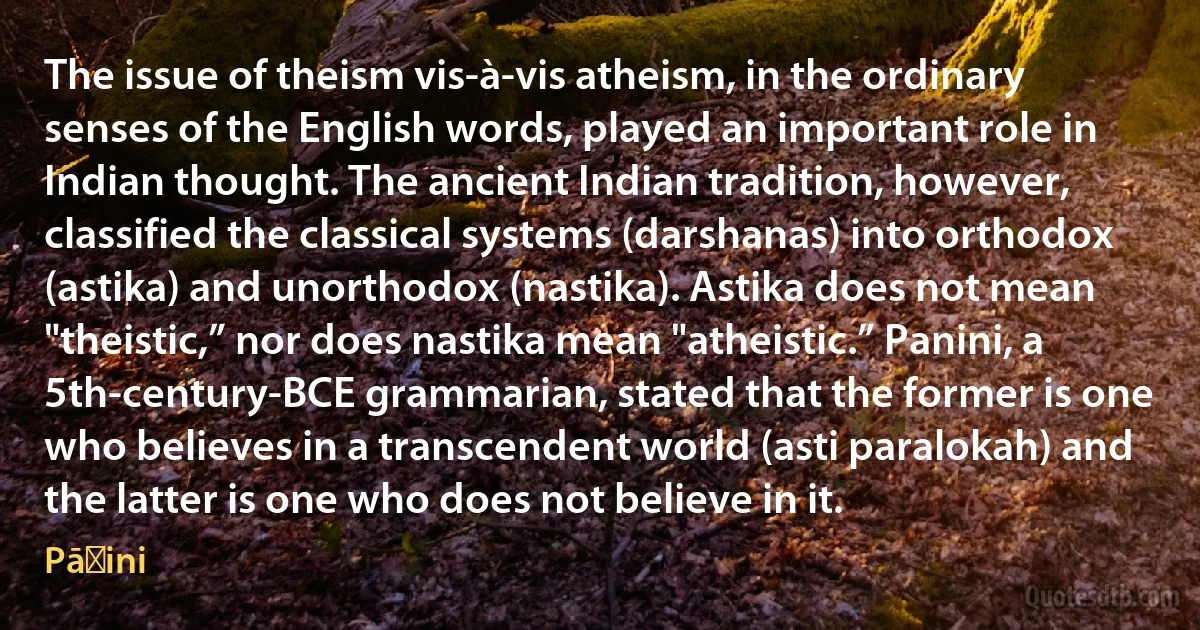Pāṇini quotes - page 2
The author of the oldest extant Sanskrit grammar was Panini, a native of extreme north-west India, ... His work consists of nearly 4000 aphorisms, each of which owing to the extreme conciseness of the style, generally consists of not more than two or three words. Hence, the whole grammar could be printed within the compass of about thirty-five octavo pages. Yet it describes the entire Sanskrit language with a completeness which has never been equalled elsewhere. Thus it is at once the shortest and the fullest grammar in the world.

Pāṇini
The Mahābhāshya was commented on in the seventh century by Bhartṛihari in his Vākyapadīya which is concerned with the philosophy of grammar, and by Kaiyaṭa (probably thirteenth century). About 650 A. D. was composed the first complete commentary on Pāṇini, the Kāçikā Vṛitti or "Benares Commentary," by Jayāditya and Vāmana.

Pāṇini
While Pāṇini's work is purely grammatical and lexicographic, cultural and geographical inferences can be drawn from the vocabulary he uses in examples, and from his references to fellow grammarians, which show he was a northwestern person. New deities referred to in his work include Vasudeva (4.3.98). The concept of dharma is attested in his example sentence dharmam carati "he observes the law"

Pāṇini
Classical Sanskrit theatre flourished during the first nine centuries CE. Aphorisms on acting appear in the writings of Panini, the Sanskrit grammarian of the 5th century BCE, and references to actors, dancers, mummers, theatrical companies, and academies are found in Kautilya's book on statesmanship, the Artha-shastra (4th century BCE).

Pāṇini
Ashtadhyayi Sanskrit treatise on grammar was written in the 6th to 5th century BCE by the Indian grammarian Panini. This work set the linguistic standards for Classical Sanskrit. It sums up in 4,000 sutras the science of phonetics and grammar that had evolved in the Vedic religion. Panini divided his work into eight chapters, each of which is further divided into quarter chapters, beyond defining the morphology and syntax of Sanskrit language.

Pāṇini
Panini was a Sanskrit grammarian who gave a comprehensive and scientific theory of phonetics, phonology, and morphology. Sanskrit was the classical literary language of the Indian Hindus and Panini is considered the founder of the language and literature. It is interesting to note that the word "Sanskrit" means "complete" or "perfect" and it was thought of as the divine language, or language of the gods.

Pāṇini
The Pāṇinian commentator Kātyāyana (c. 3rd–4th century BCE) knew of the coexistence of Middle Indic forms with earlier ones. There is a Pāṇinian rule that provides that verb bases listed in an appendix to the Aṣṭādhyāyī have the class name dhātu (verbal base, root). Kātyāyana discusses whether one could define verbal bases semantically and thereby possibly do without the verb list. He remarks that even if one defines a verbal base as denoting an action, the roots must be listed in order to preclude the possibility that constituents of terms such as āṇapayati/āṇavayati ‘commands' be assigned the class name in question; āṇapayati/āṇavayati is a Middle Indic counterpart of Sanskrit ājñāpayati.

Pāṇini



